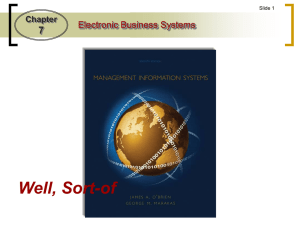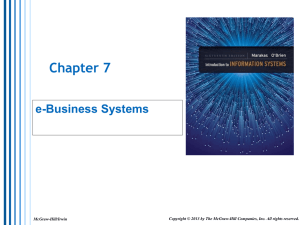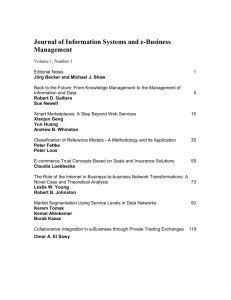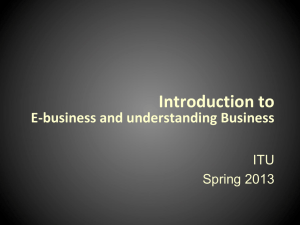Chapter 4 Electronic Business Systems
advertisement
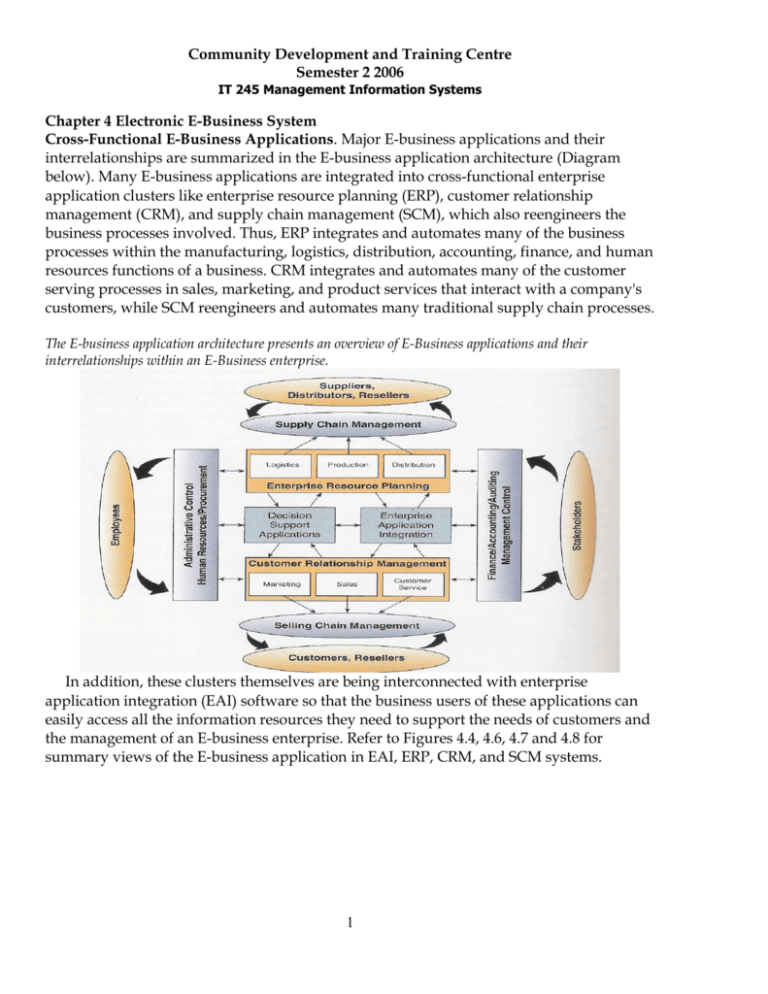
Community Development and Training Centre Semester 2 2006 IT 245 Management Information Systems Chapter 4 Electronic E-Business System Cross-Functional E-Business Applications. Major E-business applications and their interrelationships are summarized in the E-business application architecture (Diagram below). Many E-business applications are integrated into cross-functional enterprise application clusters like enterprise resource planning (ERP), customer relationship management (CRM), and supply chain management (SCM), which also reengineers the business processes involved. Thus, ERP integrates and automates many of the business processes within the manufacturing, logistics, distribution, accounting, finance, and human resources functions of a business. CRM integrates and automates many of the customer serving processes in sales, marketing, and product services that interact with a company's customers, while SCM reengineers and automates many traditional supply chain processes. The E-business application architecture presents an overview of E-Business applications and their interrelationships within an E-Business enterprise. In addition, these clusters themselves are being interconnected with enterprise application integration (EAI) software so that the business users of these applications can easily access all the information resources they need to support the needs of customers and the management of an E-business enterprise. Refer to Figures 4.4, 4.6, 4.7 and 4.8 for summary views of the E-business application in EAI, ERP, CRM, and SCM systems. 1 Figure 4.4 The major application components of enterprise resource planning demonstrate approach f ERP systems Figure 4.6 The major application clusters in customer relationship management Figure 4.7 Enterprise application integration software interconnects front-office and back-office applications clusters like customer relationship management and enterprise resource planning. Figure 4.8 Internet technologies and supply chain management software can help companies reengineer and integrate the functional processes in the supply chain life cycle. Online Transaction Processing: Online transaction processing system play a vital role in Ecommerce. Transaction processing involves the basic activities of (1) data entry, (2) transaction processing, (3) database maintenance, (4) document and report generation, and (5) inquiry processing. Many firms are using the Internet, intranets, extranets, and other networks for online transaction processing to provide superior service to their customers and suppliers. See Figure 4.11. 2 Figure 4.11 The transaction processing cycle. Note that transaction processing systems use a five –stage cycle of data entry, transaction processing, database maintenance, document and report generation and inquiry processing activities. Functional Business Systems: Functional business information systems support the business functions of marketing, production/operations, accounting, finance, and human resource management through a variety of E-business operational and management information systems summarized in Figure 4.13. Figure 4.13 Examples of functional business information system. Note how they support the major functional areas of business. Marketing: Marketing information systems, support traditional and E-commerce processes and management of the marketing function. Major types of marketing information systems include interactive marketing at E-commerce websites, sales force automation, customer relationship management, sales management, product management, targeted marketing, advertising and promotion, and market research. Thus, marketing information systems assist marketing managers in electronic commerce product development and customer relationship decisions, as well as in planning advertising and sales promotion strategies and developing the E-commerce potential of new and present products, and new channels of distribution. Manufacturing : Computer-based manufacturing information systems help a company achieve 3 computer integrated manufacturing (CIM), and thus simplify, automate, and integrate many of the activities needed to quickly produce high-quality products to meet changing customer demands. For example, computer-aided design using collaborative manufacturing networks helps engineers collaborate on the design of new products and processes. Then manufacturing resource planning systems help plan the types of resources needed in the production process. Finally, manufacturing execution systems monitor and control the manufacture of products on the factory floor through shop floor scheduling and control systems, controlling a physical process (process control), a machine tool (numerical control), or machines with some humanlike work capabilities (robotics). Human Resource Management : Human resource information systems support human resource management in organizations. They include information systems for staffing the organization, training and development and compensation administration. HRM websites on the Internet or corporate intranets have become important tools for providing HR services to present and prospective employees. Accounting and Finance : Accounting information systems record, report, and analyze business transactions and events for the management of the business enterprise. Examples of common accounting information systems include order processing, inventory control, accounts receivable, accounts payable, payroll, and general ledger systems. Information systems in finance support financial managers in decisions regarding the financing of a business and the allocation of financial resources within a business. Financial information systems include cash management, online investment management, capital budgeting, and financial forecasting and planning. Key Terms and Concepts These are the key terms and concepts of this chapter. 1. Accounting systems 3. Accounts receivable 2. Accounts payable 4. Batch processing 5. Collaborative manufacturing networks 6. Computer-aided manufacturing 7. Computer-integrated manufacturing 8. Cross-functional enterprise systems 9. Customer relationship management 10. E-business a. Application architecture 11. Enterprise application integration 12. Enterprise resource planning 13. Financial management systems 15. General ledger 17. Interactive marketing 19. Machine control 21. Manufacturing systems 23. Online accounting systems 25. Online investment systems 27. Order processing 29. Process control 31. Robotics 33. Supply chain 35. Targeted marketing 14. Functional business systems 16. Human resource systems 18. Inventory control 20. Manufacturing execution systems 22. Marketing systems 24. Online HRM systems 26. Online transaction processing systems 28. Payroll 30. Real-time processing 32. Sales force automation 34. Supply chain management 36. Transaction processing cycle 4 Review Quiz Match one of the key terms and concepts listed previously with one of the brief examples or definitions that follow. Try to find the best fit for the answers that seem to fit more than one term or concept. Defend your choices. 1. Using the Internet and other networks for Ecommerce, collaboration, and business processes. 2. Information systems that cross the boundaries of the functional areas of a business in order to integrate and automate business processes. 3. Information systems that support marketing, production, accounting, finance, and human resource management. 4. E-business applications can be grouped into clusters of cross-functional enterprise applications. 5. 6. Software that interconnects enterprise application clusters. A cross-functional enterprise application that integrates and automates key back-office processes. Information systems for customer relationship management, sales management, and promotion management. Collaborating interactively with customers in creating, purchasing, servicing, and improving products and services. Using mobile computing networks to support salespeople in the field. 7. 8. 9. 10. A cross-functional enterprise system that integrates and automates many customer serving processes. 11. Information systems that support manufacturing operations and management. 12. A conceptual framework for simplifying and integrating all aspects of manufacturing automation. 13. Using computers in a variety of ways to help manufacture products. 14. Engineers and other specialists use the Internet and other networks to participate in product or process design. Using computers to operate a petroleum refinery. Using computers to help operate machine tools. 15. 16. 17. Computerized devices with work capabilities that enable them to take over some production activities from human workers. 18. Information systems to support staffing, training and development, and compensation administration. Using the Internet for recruitment and job hunting is an example. 19. 20. Accomplishes legal and historical record-keeping and gathers information for the planning and control of business operations. 21. 22. 23. 24. 25. 26. 27. An example is using the Internet and extranets to do accounts receivable and accounts payable activities. Handles sales orders from customers. Keeps track of items in stock. Keeps track of amounts owed by customers. Keeps track of purchases from suppliers. Produces employee paychecks. Produces the financial statements of a firm. 28. Information systems for cash management, investment management, capital budgeting, and 5 financial forecasting. 29. 30. Using the Internet and other networks for investment research and trading. Performance monitoring and control systems for factory floor operations. 31. Customizing advertising and promotion methods to fit their intended audience. 32. Data entry, transaction processing, database maintenance, document and report generation, and inquiry processing. 33. 34. Collecting and periodically processing transaction data. Processing transaction data immediately after they are captured. 35. Systems that immediately capture and process transaction data and update corporate databases. 36. A network of business relationships between a business that produces a product or service and business partners involved in the processes that are required. 37. Integrates the management functions involved in promoting efficient and effective supply chain processes. Discussion Questions 1. How is E-business "redefining old business models, with the aid of technology, to maximize customer value"? 2. Why is there a trend toward cross-functional integrated enterprise systems in business? 3. What are the benefits and limitations of interactive marketing for a business? 4. Refer to the Real World Case on Siebel Systems and Telstra in the chapter. How could CRM or other E-business systems help a company build customer value and loyalty? Give an example to illustrate your answer. 5. How do you think sales force automation affects salesperson productivity, marketing management, and competitive advantage? How can Internet technologies be involved in improving a process in one of the functions of business? Choose one example and evaluate its business value. 6. 7. How can Internet technologies improve customer relationships and service for a business? 8. Refer to the Real World Cases on Alcoa and Cisco Systems and Solectron and Others in the chapter. What can the companies involved do in the future to avoid the problems revealed in the Solectron case? 9. Do you agree that "ERP is the backbone of E-business"? Why or why not? 10. What is the role and business value of using Internet technologies in supply chain management 6 7



